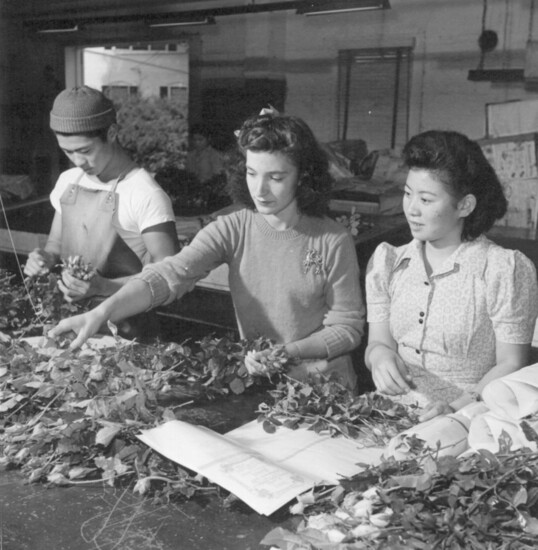Long-stemmed and graceful. Eye-catching and fragrant. Unique, like the recipients who sigh at the sight of a bouquet full of them – new mothers and treasured teachers, longtime sweethearts and blushing brides, thoughtful neighbors, and tenderhearted grandmothers.
For a time, the city was known by them – dubbed the Rose Capital of the nation – and for good reason. Over 80 years, Mount Clemens, covered in almost a million square feet of glass, was the epicenter of the rose-growing industry. The largest of eight greenhouses spanned the length of two football fields and produced upwards of 300 million roses: The Mount Clemens Rose Gardens. Prominent in the industry, even the Gerald R. Ford administration requested their delicate beauties, with shipments sent weekly to the White House for floral arrangements, state dinners, and public areas throughout the grand residence. Betty Ford especially loved the soft salmon pink-orange Sonia rose.
Owned by the Weiss family, the patriarch Prussian immigrant moved to Mount Clemens from Chicago in the 1920s. Leaving behind greenhouses that grew carnations, Paul Weiss borrowed his father’s $30,000 in life savings and bought into the Weaver greenhouses. Five years later, he purchased the established greenhouses outright. What began as an opportunity realized in a country Paul loved blossomed into a legacy he could have only imagined. Over the decades, countless young men and women spent summers at the Mount Clemens Rose Gardens, in between college or as a first-time job during high school. Daughters followed in the footsteps of their mothers as sorters, fathers made deliveries, and uncles prepared shipments. In 1943, when businesses were losing valuable workers because of the war effort, Paul petitioned the federal government to relocate several Japanese American families placed in internment camps in California after the attack on Pearl Harbor. Dozens were moved to Mount Clemens, where they joined the staff at the Mount Clemens Rose Gardens and were welcomed with open arms. These new residents even formed a baseball team and won the Recreational League Baseball Championship in 1947.
Throughout a depression and a booming economy, wars and a summer of love, novel inventions and new leaders, roses were a constant – relied on for their beauty and cheerfulness, emissaries for love and congratulations at weddings, birthdays and special occasions, and sympathy at funerals.
Paul said he got to work with God every day. It was a wonder he passed down to his son, Frederic, and his grandson, Paul II.
Commercial rose growing, though worthwhile, is a meticulous practice. At Mount Clemens Rose Gardens, more than 230,000 rose plants grew under greenhouses spread out over 58 acres of land. Standing tall in the steam-heated, oxygen-rich calm, the flowers were coaxed to push forth buds that would grow and burst. Then they were snipped, graded, wrapped and shipped.
Whether a red Forever Yours, a yellow Golden Rapture, a Pink Bountiful or even a lavender Grandiflora, a rose must be constantly rebred and developed into a new, vigorous strain. As many as 18 varieties of hybrid tea and sweetheart blooms were grown in the Mount Clemens Rose Gardens greenhouses. And to produce marketable flowers, their environments needed to be kept at a 60 to 64-degree temperature. On hot summer days, an automatic sprinkler system flushed mist through overhead pipelines and a ventilation system kept the gardens from overheating. For the winters, Paul II built a power plant in 1969 large enough to heat a town of 300 homes, switching from coal to fuel oil. It provided cleaner heat and required fewer employees. The Mount Clemens Rose Gardens utilized the nearby Clinton River for irrigation, returning the water – as it was discovered through testing by the Michigan Pollution Control Board – cleaner than when it was taken out.
When they closed their doors in 1999, the Mount Clemens Rose Gardens ranked eighth in production in the United States, producing more than 6 million roses each year. Today, the framework from one of the last remaining greenhouses sits as an open-air pergola at the Clinton Township Historical Village.
By next year, the Mount Clemens Beautification Commission hopes to showcase its own tribute to the greenhouses with rows of roses. The city block along southbound Gratiot from the Anton Art Center to Cass Avenue will not only feature a stretch of newly-planted beautiful gardens, but historical signage detailing the legacy of the Mount Clemens Rose Gardens and the Japanese Americans who came to call the community home. The commission has been approved to receive services through the Michigan State University Extension, which will assign a master gardener to oversee the design aspect of the project, as well as suggest species of roses that are low maintenance, more hearty, and less prone to disease. The commission’s goal is to tie in colors that reflect those found in the new mural on the side of the art center, which reflects the diversity that has flowed through the city for generations. Those interested in getting involved can reach out to Linda Curatolo at curatolo@comcast.net.
